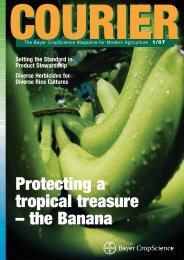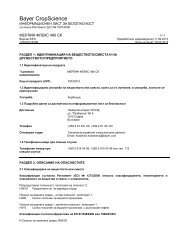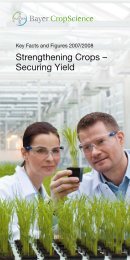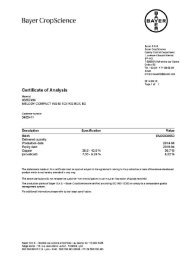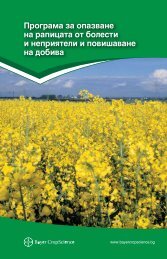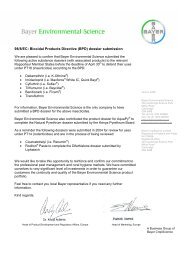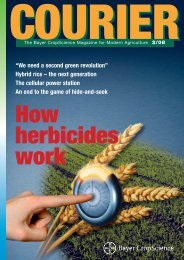Potatoes⦠- Bayer CropScience
Potatoes⦠- Bayer CropScience
Potatoes⦠- Bayer CropScience
You also want an ePaper? Increase the reach of your titles
YUMPU automatically turns print PDFs into web optimized ePapers that Google loves.
From yield reduction to total yield<br />
loss – pests such as the Colorado potato<br />
beetle (Leptinotarsa decemlineata) and<br />
aphids (e.g. Myzus persicae, Aulacorthum<br />
solani, Macrosiphum euphorbiae), cicadas,<br />
thrips, nematodes and potato moths are endemic<br />
– and threatening – in almost all of<br />
the traditional areas of potato cultivation.<br />
The Colorado potato beetle and its larvae,<br />
with their almost insatiable appetites, can<br />
eat continuously and are capable of laying<br />
waste to entire fields. In contrast, aphids<br />
do not cause damage directly through their<br />
feeding, but rather as so-called vectors of<br />
viruses which they can transfer every time<br />
they probe a plant with their proboscis. In<br />
Europe alone, 20 virus types are recognised<br />
– the potato leaf roll virus (PLRV),<br />
potato virus Y (PVY) and X (PVX) are the<br />
most important economically. The symptoms<br />
of virus infection range from leaf<br />
deformation and necroses through to<br />
growth suppression and damage to the<br />
tuber. Producers of seed potatoes must be<br />
especially careful to prevent infection:<br />
seed potatoes that carry viruses cannot be<br />
certified for selling or sowing.<br />
Safeguarding the<br />
harvest is essential<br />
“The potato is an expensive crop. Intensive<br />
cultivation in Central Europe involves the<br />
grower investing up to 3,000 Euro per<br />
hectare“, says <strong>Bayer</strong> <strong>CropScience</strong> expert<br />
Dr. Hartwig Dauck (Global Insecticides<br />
Manager for potato). This sum covers the<br />
costs for machinery, energy, work, soil,<br />
seed, crop protection and fertilizing. He<br />
continues: “If you want to avoid putting<br />
this considerable investment at risk, you<br />
have to keep an eye on pest insects right<br />
from the start.“ Preventative measures are<br />
urgently recommended, although their<br />
influence on infection levels is limited. The<br />
virus threat can be reduced by growing resistant<br />
varieties in areas that are relatively<br />
free of vectors, and long-term rotations can<br />
also reduce the risk. But seasonal weather<br />
is beyond the farmer’s control – if it is<br />
favourable for the pests, then they will be<br />
present in the field in larger numbers. This<br />
is why it is essential to take steps to safeguard<br />
yield and quality by applying the<br />
right tools at the right time.<br />
Consider damage thresholds<br />
Damage thresholds are important considerations<br />
in deciding on exactly the right<br />
time to intervene: they indicate which<br />
level of infestation can be tolerated<br />
from an economic point<br />
of view. Applying<br />
Potato aphid (Macrosiphum solanifolii)<br />
An overview of product<br />
strengths:<br />
Biscaya ® :<br />
• Highly systemic insecticide with<br />
long-term efficacy<br />
• Active against sucking and biting<br />
insects<br />
• Pests living within the plant are<br />
effectively controlled<br />
• O-TEQ-formulation: rapid uptake,<br />
increased rainfastness<br />
• Can also be used at higher<br />
temperatures<br />
• Favourable profile towards the<br />
environment and beneficials –<br />
safe for bees<br />
Proteus ® :<br />
• Combination of active substances<br />
with both systemic properties<br />
and contact activity; more rapid<br />
knock-down effect, but also longterm<br />
activity<br />
• Broad-spectrum activity against<br />
sucking and biting insects<br />
(including the potato moth)<br />
• O-TEQ-formulation: rapid uptake,<br />
increased rainfastness<br />
control measures only makes sense if the<br />
yield losses the pest is expected to cause<br />
exceed the costs of protecting the yield<br />
against the pest. Damage thresholds vary<br />
from country to country – they also depend<br />
on how the potatoes are to be used after<br />
harvest. “In the United Kingdom, the first<br />
aphid-control treatment in food and starch<br />
potatoes is recommended as soon as the<br />
aphid count reaches three to five per leaf.<br />
If the number of aphids caught in traps<br />
rises rapidly, reflecting a strong increase in<br />
the population, it’s a first warning signal“,<br />
says Dr. Dauck. “But seed potato growers<br />
must take action as soon as the first aphid<br />
is seen, otherwise they risk the virus-free<br />
status – and thus the certification – of their<br />
crop“. Depending on the region and local<br />
climatic conditions, food potatoes need up<br />
to four sprays and seed potatoes as many as<br />
twelve sprays to cover the entire cultivation<br />
period.<br />
There are also strict requirements with<br />
regard to the Colorado potato beetle: in the<br />
Netherlands for example – where farmers<br />
are actually legally obliged to control the<br />
pest – treatment must start as soon as the<br />
first larva has been found.<br />
1/08 COURIER 23





